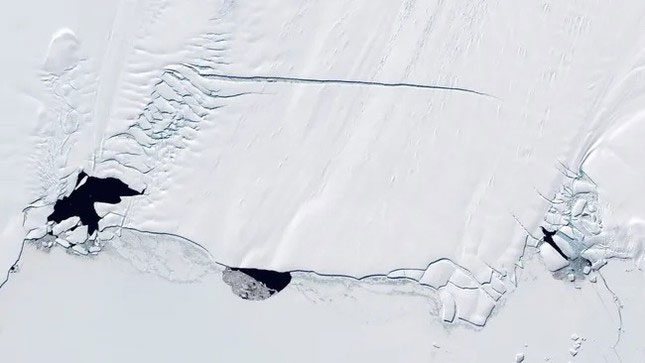A new study reveals that gigantic holes the size of cities are opening up on the ice shelf in Antarctica, which may be linked to the formation of massive icebergs breaking away from the icy continent.
The lead author, Elena Savidge, a PhD candidate at the Department of Geophysics at Colorado School of Mines in the U.S., stated: “These ‘doorways into the sub-ice environment’ could provide clues about how ice is melting deep beneath the surface.”

Three polynyas on Pine Island Glacier in Antarctica in 2001. (Image source: NASA’s Earth Observatory).
Massive ice sheets cover vast areas of Antarctica and flow toward the coast, while ice shelves float above the surrounding ocean. Savidge noted that the biggest factors leading to ice loss are surface melting and the melting of the bottom ice layer. As the ice shelf shrinks and thins, its ability to resist the flow from the glacier decreases, thereby accelerating the rate of ice loss.
To better understand the myriad factors contributing to the melting and loss of ice, Savidge and her colleagues turned to the sky to collect data on “polynyas” – large areas of open ocean that appear in the ice shelf. Although polynyas are associated with melting and fracturing on glaciers, long-term data on when and where polynyas occur have been lacking.
In a study published on November 21, 2023, in the journal Geophysical Research Letters, researchers examined the glaciers on Pine Island Glacier, which Savidge described as “one of the most vulnerable glaciers in Antarctica.”
The research team utilized satellite data to create a 22-year dataset on the changes in polynyas along the edge of Pine Island Glacier. Here, many polynyas are formed by warm seawater melting the ice from below. This melting creates pockets of warm, fresh water that lie on top of the salty seawater and can rise to the surface, sometimes breaking through to create a polynya.
They focused on the polynyas at the glacier’s edge because this is where the dynamics of the glacier and the ocean intersect. Savidge stated: “These elements develop together, especially since ocean heat drives the changes here.”
Over the 22 years of data collection, they found significant variability in the number and size of the polynyas, with a total coverage area ranging from 0 to 322 km2. The largest individual polynya recorded was in 2007, covering an area of 269 km2. It peaked just 68 days before a 714 km2 iceberg calved.
The researchers also observed that polynyas appeared at the same location for several years, but varied in size. It is possible that areas without ice are sustained and localized near the glacier front, affecting its structural integrity and how the ice shelf fractures under the pressure from the continuous glacier flow from the land.


















































